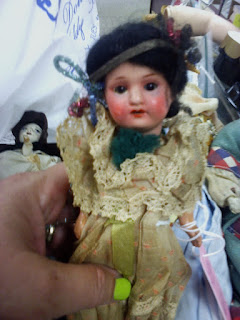Have you ever wondered why some dolls are collected and others are not? I have. For example, why are modern porcelain dolls or waldas sneered at? Why must mid century plastic dolls be mint to hold any value? What's wrong with post 1990 Alexander or Barbies? Helen young wrote on dolls called secondaries, but these dolls as she described them are now avidly
collected.
Pearce in her studies on material culture suggests it is the meaning we as ascribe to objects and their history that makes them important and worth saving. . Mass produced dolls like those described here are plentiful. They are pretty much, but have not been around long enough to create their own history.
If one of these uncollectible dolls has provenance or belonged to someone famous, it will be ascribed value. Many of the dolls in Shirley Temples collection were ordinary or damage, but they were hers, and that's made the difference. Many went to museums, and prices soared.
The same was true of the Jacqueline Kennedy Onassis auction.
Some dolls also get into museums because of their history, even if they are not valuable.

Author. Photo by Jerry Lowe.

Courtesy, ADC Magazine

Public Domain
Time changes our interpretation of what's is desirable. For example, Coleman's encyclopedia vol. 1, c. 1968 or 9 devotes only a few lines to the Albert Marque dolls, yet they write a couple of pages to bring, Jumeau and Simon & Halbig.
Marque dolls soared when one reached the $40,000+ price range. Collector's taste and purses affected the market and created a mystique for the doll.
A brief rant on some merchants into dolls solely for money. If you have to interest other than the almighty dollar, and especially if you don't collect, you might just as well sell plumbing supplies or anything else.
A good study of material culture is enlightening for doll folk. We give meaning to objects, cf utopia where golf and jewels are worthless because its inhabitants don't give them meaning.



























































wCWk~%24(KGrHqV,!h8Ew5GsnS3dBMUy3MzVPg~~_3.jpg)
















































































